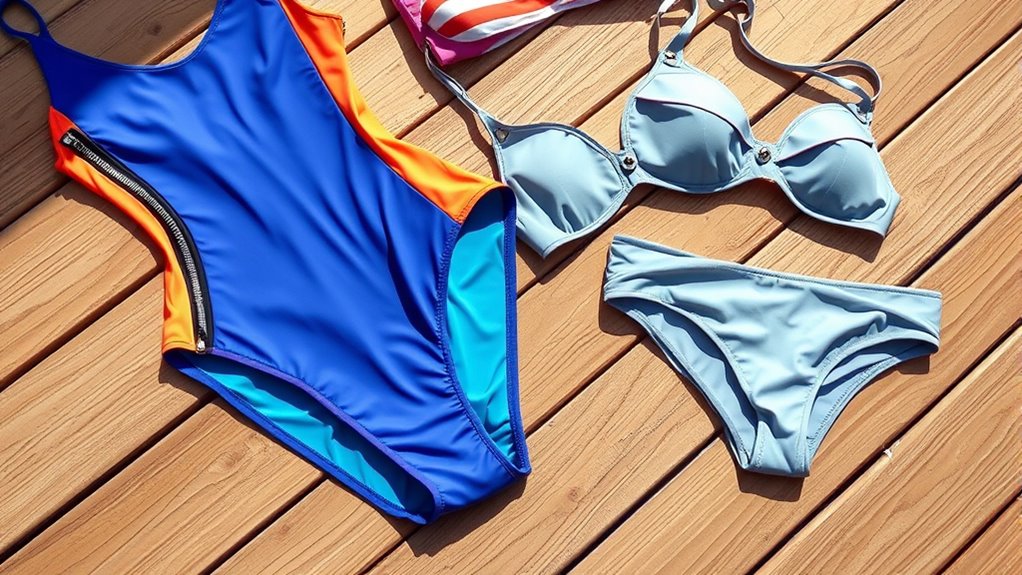When choosing swimwear, it’s important to consider hidden rules like the safety of zippers and buttons, and modesty options. Zippers should be smooth and securely sewn to prevent discomfort or wardrobe mishaps, while loose buttons can pose safety hazards or damage pool filters. Modest options, such as rash guards or cover-ups, show respect for different settings. Knowing these details helps you stay safe and appropriate—continue to discover more tips for confident swimwear choices.
Key Takeaways
- Functional zippers should be smooth and securely sewn to prevent discomfort or wardrobe malfunctions during swimming.
- Loose or decorative buttons can pose safety hazards and may damage pool filtration systems if not properly attached.
- Many pools restrict the use of zippers and buttons that could snag or cause injury, emphasizing simple, secure swimwear designs.
- Modesty options like rash guards and cover-ups are often preferred or required in family or formal swimming environments.
- Wearing appropriate swimwear demonstrates respect for rules, safety, and the comfort of all pool users.

Have you ever wondered what the proper swimwear etiquette is for different pools or beaches? It’s more than just picking a swimsuit that looks good. Knowing the rules can help you avoid awkward situations and show respect for the space and others around you. While many people focus on style, there are some lesser-known guidelines—like how zippers, buttons, and modesty options come into play—that you might not be aware of.
First, let’s talk about zippers on swimwear. Many swimsuits now feature decorative or functional zippers, but it’s important to know when and where they’re appropriate. In some pools, especially those with strict dress codes, zippers can be considered unsafe or too revealing if they catch on pool edges or equipment. Also, zippers that are functional may cause discomfort or snag on pool surfaces, so it’s best to choose designs that are smooth and secure. If you’re wearing a swimsuit with a zipper, make sure it’s properly sewn and doesn’t pose a risk of opening unexpectedly. That way, you keep your focus on swimming, not wardrobe malfunctions.
Buttons on swimwear are another detail that can influence your overall look and adherence to etiquette. Many swimsuits have decorative buttons, but some have functional ones. You want to avoid swimsuits with buttons that can come loose easily or fall off in water, as that can create safety hazards or damage the pool’s filtration system. Also, be mindful of the placement—buttons at the front or sides should be secure enough to prevent any wardrobe mishaps. If you’re heading to a more formal or upscale beach club, opt for suits with subtle or no buttons, as they tend to look more polished and respectful.
Choose swimwear with secure, subtle buttons for a polished, respectful look.
Modesty options are a significant part of swimwear etiquette, especially if you’re at a family-friendly pool or a conservative beach. Many swimsuits now come with options like rash guards, cover-ups, or tankinis that provide more coverage. While personal comfort is key, consider the setting: a skimpy bikini might be perfect for a lively beach party, but it could be inappropriate at a family pool or religious site. Some pools also have rules about topless or semi-nude dressing, so always check beforehand. Wearing modest swimwear shows respect for the environment and other visitors, and it can make you feel more comfortable in unfamiliar settings.
Additionally, understanding the importance of swimsuit construction can help you choose options that are both stylish and compliant with etiquette. Ultimately, understanding these subtle details—zippers, buttons, and modesty options—helps you navigate swimwear etiquette with confidence. It’s about respecting rules, safety, and the comfort of everyone around you. When in doubt, opt for classic, well-constructed swimsuits that balance style and appropriateness. Doing so ensures you enjoy your time in the water without worries, while also setting a good example of proper swimwear etiquette.
Frequently Asked Questions
Are Zipper Swimwear Styles Suitable for All Water Activities?
Zipper swimwear styles aren’t suitable for all water activities. You should avoid them for vigorous activities like surfing, diving, or intense swimming, as zippers can cause discomfort or damage the fabric. They’re better for casual lounging or light swimming. Make certain to check the design and material to guarantee they fit your activity level and provide comfort and safety during your water adventures.
Can Buttoned Swimwear Be Comfortably Worn in Saltwater?
Think of buttons as the secret handshake of swimwear—fancy but practical. Yes, you can comfortably wear buttoned swimwear in saltwater, but keep in mind that salt can cause buttons to corrode over time. To avoid surprises, opt for high-quality, corrosion-resistant buttons and rinse your suit thoroughly after swimming. This way, you maintain comfort and style without sacrificing durability in your aquatic adventures.
What Are the Best Modesty Options for Active Swimming?
For active swimming, you should opt for modesty options like full-coverage swimsuits, tankinis, or rash guards that stay secure and comfortable. Look for designs with supportive fabrics and adjustable features to prevent slipping. Consider swimsuits with built-in lining or compression panels for extra coverage. Avoid loose or revealing styles, and choose quick-drying, stretchy materials to stay comfortable during movement. These choices help you swim confidently and modestly.
Do Zippers and Buttons Affect the Durability of Swimwear?
Zippers and buttons can add a touch of style but might influence your swimwear’s longevity. They can create weak spots where the fabric might wear faster or snag, especially with frequent use or exposure to chlorine and saltwater. To keep your swimwear looking fresh longer, choose designs with durable closures or consider styles without them. Proper care will also help maintain the integrity of your swimwear, no matter the fastenings.
Are There Specific Care Tips for Zipper and Button Swimwear?
Yes, there are specific care tips for zipper and button swimwear. You should rinse your suit in cold water after swimming to remove chlorine or salt. Avoid harsh detergents; instead, use a gentle, swimsuit-specific cleaner. Always close zippers and buttons before washing to prevent damage. Lay your swimwear flat to dry, avoiding direct sunlight, which can weaken fabrics. Proper care keeps your zipper and button features intact longer.
Conclusion
So, next time you pick your swimwear, remember there are secret rules lurking—zippers for quick escapes, buttons for that touch of sophistication, and modesty options for when you want to blend in or stand out. Who knew your swimsuit was secretly judging your style and modesty? Don’t worry, though—just go with your gut, and maybe, just maybe, your swimwear will finally stop playing hard to get and start playing along. Happy swimming!










